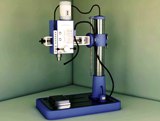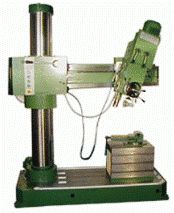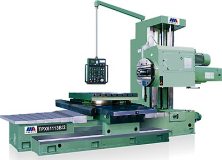Electrical equipment for drilling and drilling machines
 Drilling machines for general use include vertical drilling and radial drilling. In large-scale and mass production aggregate and multi-spindle drilling machines. Drilling machines are designed for processing large parts and are usually horizontal.
Drilling machines for general use include vertical drilling and radial drilling. In large-scale and mass production aggregate and multi-spindle drilling machines. Drilling machines are designed for processing large parts and are usually horizontal.
Electrical equipment of drilling machines
Main motion: Reversible Squirrel Asynchronous Motor, Reversible Pole-Switch Asynchronous Motor, G-D System with EMU (For Heavy Metal Cutting Machines). Total adjustment range: vertical drilling machines (2-12): 1, radial drilling machines (20-70): 1.
Drive: mechanical from the main drive chain, hydraulic drive (for modular machines). Total adjustment range: vertical drills 1: (2-24), radial drills 1: (3-40).
Auxiliary devices are used for: cooling pump, hydraulic pump, lifting and lowering the sleeve (for radial drilling machines), clamping the column (for radial drilling machines), moving the caliper (for heavy radial drilling machines), rotating the sleeve (for heavy duty radial drilling machines), table rotation (for modular machines).
Special electromechanical devices and interlocks: electromagnets for controlling the hydraulic system, automation of the cycle using travel switches (for modular machines), automatic control of the table fixation (for modular machines), automatic setting of coordinates by program control (for coordinate drilling machines and coordinate tables).

The desire to reduce the number of intermediate gears in some cases leads to a direct connection of the electric motor shaft to the drilling spindle. This is possible, for example, when using small diameter drills and is widely used in metal cutting machines in the watchmaking industry.
In modular drilling machines, self-acting heads are widely used with cam, screw or rack feed, and more often with hydraulic drive and electro-hydraulic control. Multi-spindle drilling machines often use separate electric motors for each spindle, as well as self-acting electro-hydraulic heads.
Multi-motor drive is common on radial drilling machines, where spindle drive, sleeve raising and lowering, column clamping, and sometimes sleeve rotation and drilling support movement are performed by separate electric motors. Clamping of columns on radial drilling machines is done in several ways, for example, using a split ring, which is pulled together using a differential screw turned by an electric motor or a brake shoe. Electromagnet clamping with counterspring release is also used. There are also devices where the column is clamped by a spring and released by an electromagnet.
The clamping force is monitored using a current relay or a travel switch, which is acted upon by an element of the device that moves under the action of an increasing force.
In drilling machines, automatic feed reduction when exiting the drill is essential to prevent the bit from breaking on exit. Various automation tools were used for this purpose, for example spindle speed control, torque, feed force, current consumed by the electric motor.
In multi-spindle drilling machines designed to simultaneously drill many holes of small and very small diameters, interlocks are sometimes used to stop the machine in the event of a breakage of one of the drills. To do this, the drills are isolated from the machine bed; if the drill breaks, the circuit of current passing through it is broken. Such devices have found some use in the machine tools of the watchmaking industry.
A special task is the automation of the process of deep drilling of holes with a small diameter (up to 10 mm). In such drilling, drills with a spiral groove are used, which is clogged with chips, which sharply increases the moment of resistance when rotating the drill. Therefore, drilling is carried out with intermittent drill taps, in which the chips are removed from the coolant. Management is carried out using a time relay, which, regardless of the accumulation of chips, gives a signal to track the training.
In modern drilling machines, inductive torque converters (sensors) are used for these purposes. This automatic control is more accurate because it reflects the filling of the channel with chips. It allows to increase the drilling speed and prevent the bit from breaking.
Electrical equipment for drilling machines.

Drive: mechanical — from the main drive chain, the EMU-D system for modern metal-cutting machines, thyristor drive with a constant motor. The total control range is up to 1: 2000 and more.
Auxiliary devices are used for: cooling pump, rapid movement of the drilling spindle, lubrication pump, switching gears of the gearbox, movement and tensioning of the rack, movement of the adjusting slide of the rheostat.
Special electromechanical devices and interlocks: automation of the control of the main drive when switching gears of the gearbox, devices for illumination of microscopes, devices for reading coordinates with an inductive converter.
DC motors are used to drive feeds, assembly and rapid movements of the front and rear stand, support, headstock and table. Each of these can be serially connected to one of two IPUs, one IPU providing work feeds and the other setting up accelerated offsets. Thus, during the working feed of one element, it is possible to make positioning movements of other units of the machine. The wide range of electrical adjustment of such a drive makes it possible to completely abandon the use of feed boxes. The operation of the machine is greatly facilitated by replacing handwheels, handles and handwheels with electric controls.
